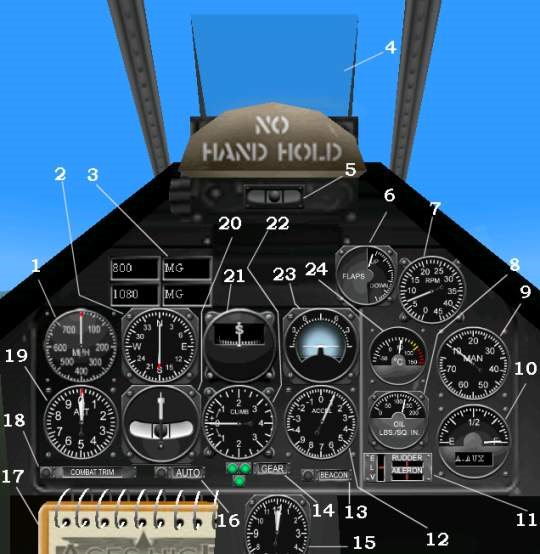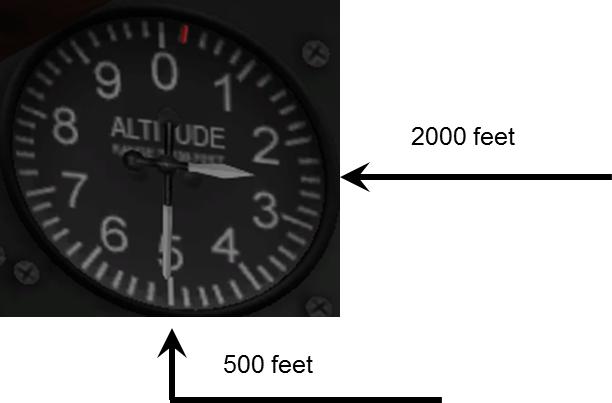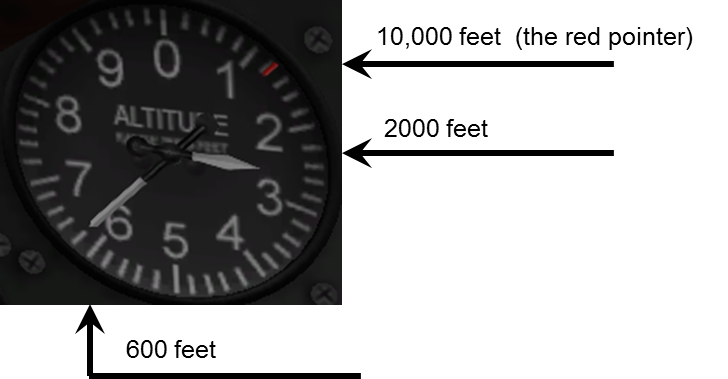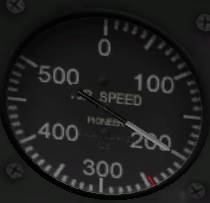Cockpit Instruments
This
picture shows the different instruments in the cockpit. Each
plane will have a different layout, and some of the instruments will be
different. Use this as a general guide to learn the different
instruments.
In addition to the regular instruments, there
is a Heads Up Display in the upper right corner of the
screen. A
real WWII airplane did not have the HUD, but it is included in game
because some instruments are harder to read in game then they would be
in real life.

1. Airspeed Indicator - White line shows
your indicated airspeed, red marker shows your true airspeed. Indicator
reads in MPH.
2. Compass
3. Ordnance Display - Selected ordnance and
count
4. Gunsight
5. Slip Indicator - Ball indicator shows
slip/skid
6. Flap Position Indicator
7. Propellor RPM Indicator
8. Oil Pressure
9. Manifold Pressure Gauge
10. Fuel Tank Quantity and Fuel Tank
Selection - Shows quantity of tanks and which tank is currently
selected. You can run in auto mode which will select tanks for CG
balance.
11. Surface Trim Indicators - Shows
position of rudder, elevator and aileron trim tabs
12. Accelerometer - Number of G's aircraft
is pulling
13. Beacon - Shows your connection status
to the host
Grayed out
- Nothing wrong
Green -
Slight variance
Yellow -
Problem exists
Red - Your
connection is being lost
14. Landing Gear Indicator - Green
indicates gear down, grayed out indicates gear retracted, yellow
indicates gear in transit.
15. Clock - Shows current server time if
online, adjusted time if set offline
16. Auto-pilot Indicator
17. Clipboard - Used for maps, roster, and
mission planning
18. Combat Trim Indicator
19. Altimeter - Shows your current altitude
in feet
20. Turn and Bank Indicator
21. Compass
22. Vertical Speed Indicator -
Climb/descent speed in thousands of feet per minute
23. Artificial Horizon
24. Engine Temperature
Two instruments that need a little
more explanation are the altimeter, and the airspeed indicator. Both of these are
available in the Heads Up
Display in the upper right corner of your screen.
The
altimeter shows your altitude above sea level.
There are three pointers, the big hand (like a clock), the
little hand,
and the red outer pointer. The
big hand
shows hundreds of feet. The
little hand
shows thousands of feet. And
the red
outer pointer shows tens of thousands of feet.
You need to be able to read this at a glance.
(Note: The red pointer can be hard to see on some displays)
So this altimeter is showing an
altitude of 2,500 feet.

This
altimeter is
showing an altitude of just over 12,600 feet.

Now the airspeed indicator is a
little more interesting. In
airplanes,
we have three speeds to measure: The
indicated airspeed, the true airspeed, and the ground speed. In real airplanes, there
are actually a few
more, but in Aces High, we only have to deal with these three.
In
a car, the speedometer tells you how fast you are traveling over the
ground,
based on how fast the tires are turning.
In an airplane, the airspeed indicator tells you how fast
you are
traveling through the air. On
an
airplane there is a small tube called a pitot tube (pronounced pē-tow).
The airspeed is measured by the force of the
air pushing into the pitot tube as the plane is flying.
This
gets a little more complicated because at higher altitudes, the air is
thinner,
which throws the measurements off.
So
the airspeed indicator shows the "indicated airspeed", and the pilot
has to make a correction to calculate the "true airspeed", or how
fast the plane is really traveling through the air.

So in this picture, the indicated
airspeed is 200 miles per hour. The
little red pointer is showing that our true airspeed is about 240 miles
per
hour. (Again, the red pointer is hard to
see on some displays) Real WWII airplanes
didn't have
the little red pointer. The
pilot had to
make the calculation himself.
The
ground speed is a measure of how fast I am traveling over the ground,
and is
calculated based on the true airspeed, and the speed and direction of
the
wind. So if the
wind is blowing from the
west at 20 mph, and I am flying west at 200 mpg TAS (True AirSpeed),
then my
ground speed is 180 mph. If
I turn
around and fly east, my ground speed would be 220 mph.
To calculate all these things, a pilot
uses an instrument called an E6B.




